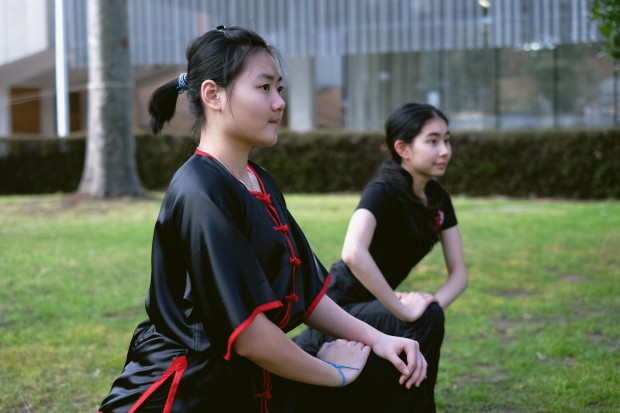The art of wushu: Inside the Melbourne University Tai Chi & Wushu Club
FROM a Sri Lankan student who rose to stardom to a young Chinese man who has claimed gold medals, Trinh Le speaks to expert wushu practitioners and shares his own experience training in this Chinese martial art.
You’ve seen it on the big screen. You’ve come to admire the lightning speed of Bruce Lee, the powerful kicks of Jet Li, the witty mind of Jackie Chan, and even the animated adventures of the “Kung Fu Panda” Po. But do you know the type of martial art these screen icons are flaunting on camera?
It’s not karate nor taekwondo, and is definitely not kung fu — a term wrongly coined by Hollywood filmmakers. Its proper name is wushu, a blend of Chinese traditional martial arts and modern sports.
As a big fan of Jackie Chan’s films, I fortunately didn’t have to travel to China to learn all about wushu. I made sure to search for a wushu club once I arrived in Melbourne and had settled with the Melbourne University Taichi & Wushu Club.
The club’s head coach Lily Sun, a middle aged woman, is not intimidatingly tall, but extremely vivacious. She might not be the stereotypical white-bearded monk on a mountain but she is a 7th Duan Associate Professor of Wushu and Tai Chi from Wuhan University (China) and has been awarded Most Successful Coach several times during her tenure.
There is a special kind of sparkle in her eyes whenever she throws a punch or strikes a kick which marvels new students. “You’re so cool. I want to be like you,” they say.
Later, Master Lily explains the importance of spirit in wushu.
“No matter how hard you punch, if you don’t show the spirit, your routine will look weak. Punching! Looking! Hah!”
After spending more than half an hour to properly warm up and stretch all possible muscles I can think of, we line up to practise stances and kicks. I notice a good mix of people from different backgrounds in the club’s members: there are students of all ages from Australia, China, Malaysia, Singapore, Vietnam and several other countries.
“One,” Master Lily shouts as she walks around the space fixing our postures.
“Lower, lower your stance! I’m not [continuing] if you’re not lowering your stance,” she says.
All her requirements – longer stretch, lower stance, faster kick, and stronger punch – are well summed up in her favourite phrase, “Not that comfortable!”
“Two!”
My legs start shaking a bit. I try to distract my mind.
“Don’t waste time when you come training. Work hard now, reward later,” Lily says.
Modern wushu was properly established in 1949, in an effort to formalise all martial arts practice in China, and has been continuously fine-tuned and developed ever since. The latest routines were added in 1992.
As a modern interpretation of ancient hand-to-hand combat disciplines and weapon techniques, wushu seeks to find a common voice among the thousands of fighting styles scattered throughout China’s regions and its history. It seeks the basic principles of martial arts and the shared commodity in every style, be it Shaolin or Tai Chi.
Once the basics are mastered, students can choose a discipline based on their specific strength and body type.
The most widely practised of these disciplines is Changquan, which requires significant speed, power, accuracy, and flexibility.
Nanquan, on the other hand, requires less flexibility but greater stability and more explosive power.
Taichichuan, despite its soft and peaceful look, is essential to develop balance, strength, flexibility, and whole body co-ordination.
And in that manner, anyone can practice wushu without fear of their body type.
As Shan, a senior member of the club, puts it, “It’s about understanding your body, how it works, which parts to move, and how to take full control of it”.
Coming from Sri Lanka five years ago as a media student, Shan didn’t know he was going to become a “wushu star”. But fate smiled on him the moment he joined the Melbourne University Tai Chi and Wushu Club.
From there he was admitted to the Australian National Wushu Team in 2014 and recently won the Gold Medal at the 2015 Australian Kung Fu Wushu Championships. Shan was even personally complimented by Arnold Schwarzenegger for his wushu performance at the 2015 Arnold Classic Australia multi-sport festival.
According to Shan, what distinguishes wushu from other team sports is the fact that everybody helps each other to advance. It’s more focused on self-development than “beating the other guy”.
Xingda Chen, another senior member of the club, comments, “To me, the wushu club is like a big family. We train together and care about each other.” Chen has won three gold medals at the 2012 Singapore International Traditional Wushu Competition.
As physically demanding as it is, wushu is essentially about honing one’s willpower, maintaining one’s spirit and being mindful of every physical movement.
For beginners, it might be intimidating to see the seniors perform their wushu techniques with such strength, smoothness, co-ordination, and spirit. But the question is not, “How long did they train?” but rather, “How long will you keep on training and improving yourself?”
After all, wushu is a personal journey of self-improvement, as explained by Master Lily Sun.
“There is no secret. You just have to practise and repeat. Practise a punch or a kick a thousand times, and you’ll see the difference. Ask anyone who has been in the club for many years, I don’t hide anything from you. Just practise.”





